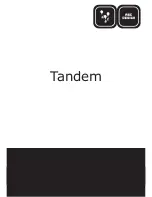
1.
Power Switch
: Switches power from the “15V IN” terminals to the SCADA
3000 circuitry. Also applies power to the “AUX PWR” terminals and will
charge and/or operate from a battery connected to the “BAT” terminals.
2.
Control Enable/Disable Switch
: Manual override switch to disable or stop
the ladder, C control, and PID programs from running. The software can be
used to start and stop the control programs only if the switch is in the Enable
position. If the switch is set to the Disable position the programs cannot be
started.
3.
Monitor Enable/Disable Switch
: Manual override switch to disable or stop
the unit from monitoring for alarms, thereby preventing alarm dialout. The
software can be used to enable and disable monitoring only if this switch is in
the Enable position. If the switch is set to the Disable position, then monitor-
ing cannot be enabled via software control.
4.
RS232 DCE Port (COM1)
: Programming port for connection to an IBM or
compatible computer. Defaults to 38.4 Kbps. (See Appendix D for details)
5.
RS232 DTE Port (COM 2)
: Multi-use communications port for use with a
radio modem, or other optional device. Defaults to 38.4 Kbps. (See Appendix
D for details)
6.
Fuses
: Left to right: 24V .5A Fuse, 4A Battery Fuse, Auxiliary 3A Power Fuse,
15V 4A Main Fuse.
7.
Power Terminal Strip
15V IN: Main power input.
AUX PWR: Output power for I/O expansion modules.
EG: Earth ground.
BAT: External 12V battery input.
24V OUT: 24V power source for powering accessories or transducers.
8.
EG Header
: Jumper to connect/disconnect circuit board ground to earth
ground.
9.
Output Terminal Strip
: Eight latching relay outputs rated to 125VAC 2A.
10.
Output LEDs
: LEDs to indicate the ON/OFF status of each output relay (0-
7).
11.
LCD Display
: 80 character back-lit programmable display for showing data
points, system status, and alarms.
12.
Keypad Buttons
: Four keypad buttons that work in combination with the dis-
play to access information and program the display.
13.
Status LEDs
ALARM
: When flashing, this LED indicates that an unacknowledged alarm
exists. When on steady it indicates that an alarm exists but has been acknowl-
edged.
FAULT
: This LED indicates a problem with the SCADA 3000 or one of the
I/O modules. The problem can be identified by viewing the system diagnostics
and unit event log.
CNTRL
(Control Program Enabled): Indicates that the control program is
enabled.
MON
(Monitoring Enabled): Indicates that alarm monitoring is enabled. If
an alarm occurs the SCADA 3000 will initiate its alarm dialout sequence.
1-3
Chapter 1: Introduction
Содержание Sensaphone SCADA 3000
Страница 1: ...Sensaphone SCADA 3000 User s Manual Version 2 34...
Страница 6: ...vi SCADA 3000 User s Manual...
Страница 10: ...x SCADA 3000 User s Manual...
Страница 30: ...1 6 SCADA 3000 User s Manual...
Страница 48: ...4 6 SCADA 3000 User s Manual...
Страница 70: ...9 8 SCADA 3000 User s Manual...
Страница 122: ...12 8 SCADA 3000 User s Manual...
Страница 190: ...15 30 SCADA 3000 User s Manual...
Страница 211: ...lead 1 lag 0 else lead 0 lag 1 16 21 Chapter 16 Programming in C...
Страница 212: ...16 22 SCADA 3000 User s Manual...
Страница 236: ...21 8 SCADA 3000 User s Manual...
Страница 248: ...22 12 SCADA 3000 User s Manual...
Страница 258: ...23 10 SCADA 3000 User s Manual...
Страница 274: ...25 8 SCADA 3000 User s Manual...
Страница 288: ...27 8 SCADA 3000 User s Manual...
Страница 294: ...28 6 SCADA 3000 User s Manual...
Страница 296: ...A 2 SCADA 3000 User s Manual...
Страница 302: ...D 2 SCADA 3000 User s Manual...
Страница 318: ...I 2 SCADA 3000 User s Manual...
Страница 320: ...J 2 SCADA 3000 User s Manual...
Страница 322: ...K 2 SCADA 3000 User s Manual...
Страница 335: ...Test Log...
Страница 336: ......
















































